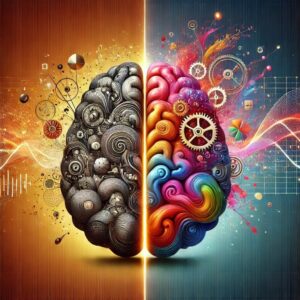Have you ever wondered what happens in the brain when you solve a complex problem or come up with a brilliant idea? The intricate dance between creativity and analytical thought is more than just a philosophical concept; it’s deeply rooted in the structure and activity of the brain. As researchers dig deeper into the neuroscience behind these mental processes, they reveal fascinating insights about how our brains function and how we toggle between imaginative and logical modes of thinking.
Creativity is often thought to be spontaneous, unrestrained, and linked to the right hemisphere of the brain. However, recent studies show that creativity involves complex networks across both hemispheres, particularly the default mode network (DMN), which is active during unfocused states like daydreaming or mind-wandering. When we let our minds wander, the DMN allows for a free flow of thoughts, enabling new connections between seemingly unrelated ideas. This is why some of our best ideas often come when we’re relaxed or in the shower—the brain’s natural ability to link ideas and concepts is at play.
Creative thought doesn’t rely solely on letting ideas flow but also uses regions like the prefrontal cortex, which is generally associated with planning and decision-making. Here, divergent thinking happens—our ability to generate many ideas or solutions to a problem, often in surprising ways. It’s the brain’s way of testing and filtering ideas, adding an analytical element even to creative thinking.
While creativity thrives on the open-ended possibilities of divergent thinking, analytical thought is grounded in focused, structured thinking—called convergent thinking. When we switch to analytical modes, the brain taps into its executive control network, especially regions like the left prefrontal cortex, which helps us apply logic, assess accuracy, and eliminate unnecessary details to arrive at specific solutions.
Analytical thinking requires intense focus and involves the dorsolateral prefrontal cortex, which directs attention and short-term memory. This network is active when we perform complex calculations, analyze arguments, or solve puzzles. But it’s not about suppressing creativity; rather, analytical thinking allows us to narrow down options and work through processes that lead to precision and clarity.
One of the most intriguing aspects of cognitive neuroscience is how the brain transitions between creative and analytical states. The process isn’t random—neuroimaging studies reveal that specific regions light up or quiet down depending on the task. When a task requires open-minded brainstorming, the brain leans into the DMN, while it engages the executive control network for structured problem-solving.
Interestingly, people with highly developed creative skills often show an exceptional ability to move fluidly between these networks, suggesting that mental flexibility is key to achieving a balance between creativity and analysis. This balance may even be trainable through practices like mindfulness and meditation, which allow us to manage our focus and awareness better.
Why is it so important to know what happens in the brain during these mental processes? Understanding the balance between creativity and analysis can have far-reaching applications—from enhancing education to optimizing workplace productivity. By knowing how to engage the brain in different types of thinking, we can improve everything from how students approach learning to how professionals solve problems in dynamic environments.
In fields like business and innovation, where both out-of-the-box thinking and meticulous analysis are required, tapping into the neuroscience of these processes could lead to breakthroughs. It may even offer insights into conditions like ADHD or dyslexia, where people often show unique patterns of creative and analytical thought.
Our brains are remarkably adaptable, switching between different thinking modes as needed. By gaining a better understanding of how we toggle between creativity and analytical thought, we unlock the potential for richer ideas, clearer solutions, and an overall better grasp of the complex machinery inside our heads.

